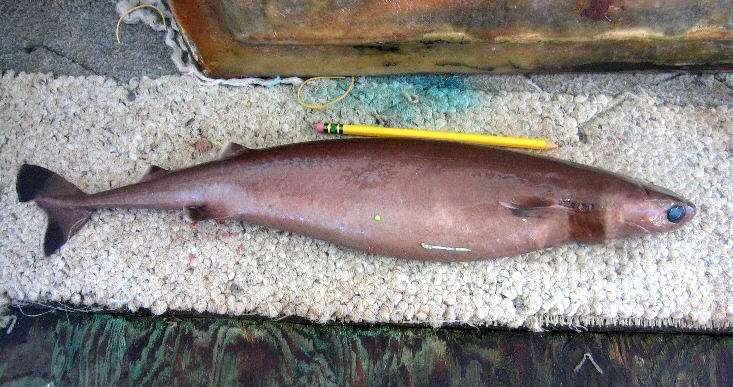When we think of sharks, we generally think of big sharks, apex predators, the top of the food chain. But there is actually a small shark with a maximum length of 56 cm (or about 22 inches) that preys on marine predators over 10 times its own body length. It is called
Isistuius brasiliensis or the Cookiecutter Shark.
 |
Cookiecutter Shark size next to a pencil
en.wikipedia.org |
It is known to attack and bite a wide variety of large animals including seals, whales, orcas, porpoises, pelagic fishes, sharks, and even a human swimmer. It is able to prey on large animals like this because it has a unique feeding strategy, dentition, tongue and mouth morphology. It uses this to scoop out a hemispherical plug of flesh from its prey.
 |
Teeth and jaws of Cookiecutter Shark
australianmuseum.net.au |
It is found throughout tropical and subtropical waters and it's range also extends as far south as New Zealand waters where its prey items could now include white sharks. A bite on a white shark from a Cookiecutter shark was observed. It has not been previously documented that a Cookiecutter shark would bite a white shark. There has been photographic evidence showing that they do indeed prey on white sharks. The bite wounds from Cookiecutter sharks are basically an oval bowl shape cut out of the flesh of their prey. Researchers think that they Cookiecutter shark comes in contact with the white shark when it moves to surface waters at night when it performs it's vertical migrations throughout the day.
 |
Cookiecutter shark bite on a white shark
phenomena.nationalgeographic.com |
Researchers think that the Cookiecutter shark may attract upward-looking predators using their ventral photophores (a light producing organ in some fishes) and a collar of pigmented cells posterior to the head as a lure. Because the bite on the shark is close to the mouth adds to that theory that the white shark was trying to eat the Cookiecutter and got bit then. Cookiecutters have been frequently reported to prey on beaked whales, sperm whales, some porpoises, and baleen whales. It is thought that this prey either represents less of a threat to the Cookiecutter or it provides a higher caloric content because of the higher blubber composition on marine mammals. Previously it was found that orcas suffer from bites from Cookiecutters. It is now known that two of the largest marine predators are victims to the Cookiecutter shark. White sharks are not as invincible as I once thought, and not only do they have to worry about parasites but also a fish that is less than two feet long taking a chunk out of them. I did not know that the Cookiecutter shark existed before this and it was really cool to learn that they prey on apex predators.
Source: Hoyos-Padilla, Mauricio, Yannis P. Papastramatiou, et al. Observation of an attack by a Cookieshark (Isistuius brasiliensis) on a White Shark (Carcharodon carcharias). 2013. Pacific Science 67, 1:129- 143.



As if leeches weren't freaky enough! Your intro and pictures sort of scared me from the beginning. I actually plan on taking a trip to New Zealand next year. Maybe if I see one, I can let you know! :)
ReplyDeleteWhat brave sharks! I am sure there is plenty of smaller prey in the ocean that they could choose from, but they attack white sharks!? The energy payoff must be large for them not to be afraid of being eaten by the prey themselves!
ReplyDeleteThis was a really neat article! It blows my mind that something so small could prey on a whale! Thank you for sharing!
ReplyDeleteI myself was not aware such a shark existed. I knew of smaller sharks but who knew of a tenacious little guy who can much on a Great White. Clearly these guys won't be in any danger of extinction since they are able to feed on such a wide range of predators. Very cool!
ReplyDelete